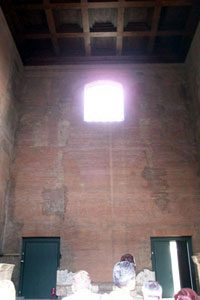
These students are standing on the old sacred places in front of the Senate building
The Senate of the city of Rome first began meeting about 500 BC, with the beginning of the Roman Republic. This was about the same time that Athens established its democracy and Carthage‘s Senate also started meeting. Voters elected some of the richest men in Rome to serve in the Senate (These men prevented women from being in the Senate). The first Senate house was, according to Livy, built before there even was a senate, by one of the kings of Rome, Tullius Hostilius.It was in the Roman Forum, near some old sacred places (one was called the Lapis Niger, the Black Rock) where people felt close to powerful gods.

Front of the Curia, or Senate House
Later people tore down the first Senate building to make room for a new forum, and so Julius Caesar began to build a new senate house. After the other senators killed Julius Caesar in 44 BC, Caesar’s nephew Augustus dedicated the new senate house to Julius Caesar’s memory. That’s pretty funny, because the Senate killed Caesar for trying to make himself king, and Augustus did make himself Emperor. That’s what he’s reminding the Senate of by dedicating the Senate to Caesar.

Front of the Curia, or Senate House
When a fire burned down Julius Caesar’s Senate building in the late 200s AD, the emperor Diocletian had a new Senate house built in the latest architectural style. This is the Senate house that is still standing today. It is still in the same place, in the Roman forum.
The Senate house Diocletian had built is all made of brick, but when it was new it would have had a coating of marble and stucco all over it. The marble floor is still there to give you an idea.

The patterned marble floor of the Roman Senate’s meeting room
The colored marble used in this floor came from many different parts of the Roman Empire, to show that the Senate controlled so many different places and was very powerful. The reddish-purple stone is porphyry (POUR-fir-ee) from Egypt, and the yellow marble is from Nubia, in Africa south of Egypt (modern Sudan), which wasn’t even really in the Roman Empire. The green marble (serpentine) is from Asia Minor (modern Turkey).

The Senate house also had great big bronze doors on it. (One of the Popes moved those doors to a Christian church in Rome, and that’s where they are now).
The Senate met in this building for another 300 years after it was built, but with Roman government moved to Constantinople the Senate gradually stopped meeting (the last recorded meeting was in 580 AD). The Senate house is still in pretty good shape today, with a roof on it, because, like the Pantheon, the emperor Phocas gave it to the Popes to turn into a Christian church in the early 600s AD and the Popes took good care of it.
Learn by doing: copy this marble floor pattern on to drawing paper and color it
More about the Roman forum
Bibliography and further reading about the Roman Senate House:
The Colosseum & the Roman Forum, by Martyn Whittock (2002). Easy reading.
The Roman Forum, by Michael Grant (1970). Out of date, but Michael Grant is an entertaining writer with a simple style which teenagers may appreciate.